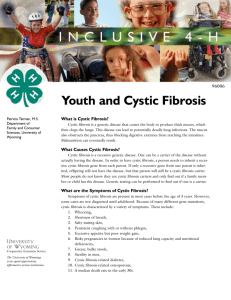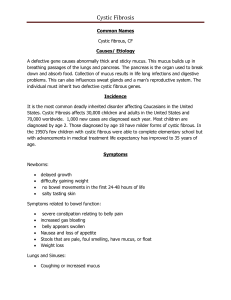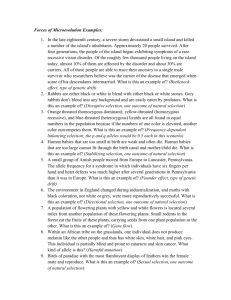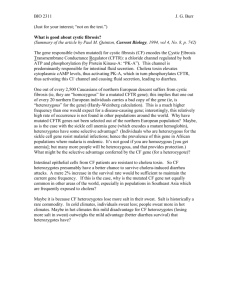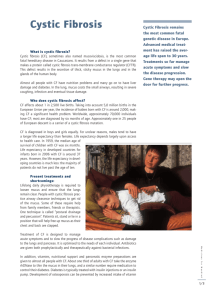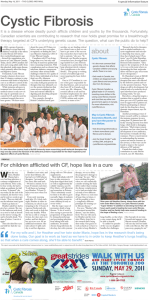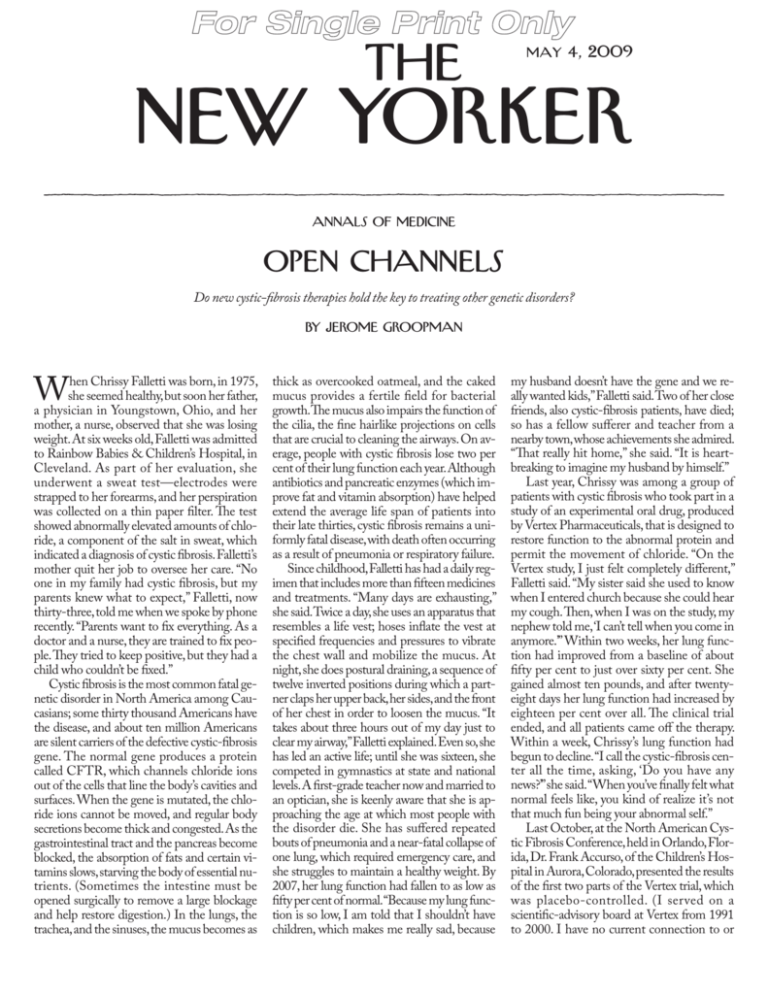
THE
may 4, 2009
NEW YORKER
Annals of medicine
open channels
Do new cystic-fibrosis therapies hold the key to treating other genetic disorders?
by Jerome Groopman
W
hen Chrissy Falletti was born, in 1975,
she seemed healthy, but soon her father,
a physician in Youngstown, Ohio, and her
mother, a nurse, observed that she was losing
weight. At six weeks old, Falletti was admitted
to Rainbow Babies & Children’s Hospital, in
Cleveland. As part of her evaluation, she
underwent a sweat test—electrodes were
strapped to her forearms, and her perspiration
was collected on a thin paper filter. The test
showed abnormally elevated amounts of chloride, a component of the salt in sweat, which
indicated a diagnosis of cystic fibrosis. Fal­letti’s
mother quit her job to oversee her care. “No
one in my family had cystic fibrosis, but my
parents knew what to expect,” Falletti, now
thirty-three, told me when we spoke by phone
recently. “Parents want to fix everything. As a
doctor and a nurse, they are trained to fix people. They tried to keep positive, but they had a
child who couldn’t be fixed.”
Cystic fibrosis is the most common fatal genetic disorder in North America among Caucasians; some thirty thousand Americans have
the disease, and about ten million Americans
are silent carriers of the defective cystic-fibrosis
gene. The normal gene produces a protein
called CFTR, which channels chloride ions
out of the cells that line the body’s cavities and
surfaces. When the gene is mutated, the chloride ions cannot be moved, and regular body
secretions become thick and congested. As the
gastrointestinal tract and the pancreas become
blocked, the absorption of fats and certain vitamins slows, starving the body of essential nutrients. (Sometimes the intestine must be
opened surgically to remove a large blockage
and help restore digestion.) In the lungs, the
trachea, and the sinuses, the mucus becomes as
thick as overcooked oatmeal, and the caked
mucus provides a fertile field for bacterial
growth.The mucus also impairs the function of
the cilia, the fine hairlike projections on cells
that are crucial to cleaning the airways. On average, people with cystic fibrosis lose two per
cent of their lung function each year. Although
antibiotics and pancreatic enzymes (which improve fat and vitamin absorption) have helped
extend the average life span of patients into
their late thirties, cystic fibrosis remains a uniformly fatal disease, with death often occurring
as a result of pneumonia or respiratory failure.
Since childhood, Falletti has had a daily regimen that includes more than fifteen medicines
and treatments. “Many days are exhausting,”
she said. Twice a day, she uses an apparatus that
resembles a life vest; hoses inflate the vest at
specified frequencies and pressures to vibrate
the chest wall and mobilize the mucus. At
night, she does postural draining, a sequence of
twelve inverted positions during which a partner claps her upper back, her sides, and the front
of her chest in order to loosen the mucus. “It
takes about three hours out of my day just to
clear my airway,”Falletti explained. Even so, she
has led an active life; until she was sixteen, she
competed in gymnastics at state and national
levels. A first-grade teacher now and married to
an optician, she is keenly aware that she is approaching the age at which most people with
the disorder die. She has suffered repeated
bouts of pneumonia and a near-fatal collapse of
one lung, which required emergency care, and
she struggles to maintain a healthy weight. By
2007, her lung function had fallen to as low as
fifty per cent of normal.“Because my lung function is so low, I am told that I shouldn’t have
children, which makes me really sad, because
my husband doesn’t have the gene and we really wanted kids,” Falletti said. Two of her close
friends, also cystic-fibrosis patients, have died;
so has a fellow sufferer and teacher from a
nearby town, whose achievements she admired.
“That really hit home,” she said. “It is heartbreaking to imagine my husband by himself.”
Last year, Chrissy was among a group of
patients with cystic fibrosis who took part in a
study of an experimental oral drug, produced
by Vertex Pharmaceuticals, that is designed to
restore function to the abnormal protein and
permit the movement of chloride. “On the
Vertex study, I just felt completely different,”
Falletti said. “My sister said she used to know
when I entered church because she could hear
my cough. Then, when I was on the study, my
nephew told me, ‘I can’t tell when you come in
anymore.’ ” Within two weeks, her lung function had improved from a baseline of about
fifty per cent to just over sixty per cent. She
gained almost ten pounds, and after twentyeight days her lung function had increased by
eighteen per cent over all. The clinical trial
ended, and all patients came off the therapy.
Within a week, Chrissy’s lung function had
begun to decline. “I call the cystic-fibrosis center all the time, asking, ‘Do you have any
news?’ ” she said. “When you’ve finally felt what
normal feels like, you kind of realize it’s not
that much fun being your abnormal self.”
Last October, at the North American Cystic Fibrosis Conference, held in Orlando, Florida, Dr. Frank Accurso, of the Children’s Hospital in Aurora, Colorado, presented the results
of the first two parts of the Vertex trial, which
was placebo-controlled. (I served on a
scientific-advisory board at Vertex from 1991
to 2000. I have no current connection to or
years earlier, Dr. Francis Collins, at Yale, had devised a technique to find a gene by “jumping”
over segments of chromosomes. “It’s like looking for a burned-out light bulb in the basement
of somebody’s house,” Collins told me. “You
search the whole United States, and then you
narrow it down to the right state, maybe even
the right county, but you still have an awful lot
of territory to search through for the burnedout light bulb. You needed a method that would
allow you to do a house-to-house search—ideally, one that would allow you to start searching
function. Their findings were published as a
series of three papers in the journal Science.
The discovery of the gene set off a wave of
euphoria, with many people convinced that
cystic fibrosis would soon be cured. Collins recalled, “You know the affected organs, the
lungs and pancreas, you deliver the normal
gene, and, bingo! You’d be done.” The N.I.H.
spent millions of dollars setting up gene-therapy centers to attempt just that. In 1990, a year
after the gene was discovered, researchers published papers on successful laboratory tests in
prestigious journals like Nature and
Cell.The New York Times reported,
“Scientists have cured cystic fibrosis
cells in the laboratory by inserting
a healthy version of the gene that
causes the disease, an unexpectedly
swift advance that left researchers
almost giddy with delight. The results throw open the door to using
human gene therapy to treat the
deadly respiratory disorder, the
most common fatal genetic ailment
in the United States.” Yet, despite
the successes in the laboratory, patients had an immune reaction to
the procedure, rejecting the delivery
system that held the normal gene.
For those who had invested
their hopes in the therapy, the disappointment was devastating. Last
November, I visited the Cystic Fibrosis Clinic at Children’s Hospital
Boston with Dr. Ahmet Uluer, a
pediatric pneumologist and the director of the adult cystic-fibrosis
program. The mood was sombre: a
few days earlier, Dean Barnett, a
conservative columnist and political activist in Boston, who had cyshe characteristics of cystic
tic fibrosis, had died, at the age of
fibrosis have long been recogforty-one. In one examination
nized, if not always understood. In
room, Sabrina Kelley, a twelvemedieval times, a baby who tasted
year-old patient, and her father,
“salty” when kissed would be predicted to die under an evil hex; the Some drugs seem to restore a mutated protein to its normal function. Brian, a Massachusetts state
trooper, were waiting for the docautopsy of an emaciated, “bewitched” eleven-year-old girl in 1595 in multiple city blocks at once. And that’s essen- tor. Sabrina had been running a fever for several days; during the previous year, she had
Leiden, the Netherlands, revealed that the pan- tially what chromosome jumping allowed.”
creas was swollen, hard, and gleaming white.
The technology could identify mutations— spent weeks on intravenous antibiotics for
The name of the disease describes this effect: the burned-out light bulb—in any genetic dis- sinus infections and lung infections. “Sabrina
fluid-filled cavities, or cysts; and prominent order, but Collins chose to focus on cystic was born in 1996, when it was all about gene
scarring, or fi­­brosis. Dr. Dorothy Hansine An- fibrosis, in part because of a young woman he therapy,” Brian Kelley said. He paused and
dersen, a pediatrician at Columbia Univer­­-sity’s had treated as an intern, in 1977. “I became in- looked at Dr. Uluer. “You doctors were supBabies & Children’s Hospital, in New York terested in the condition, and frustrated when posed to fix it,” he said. Kelley has been followCity, was the first to identify cystic fibrosis as a I tried to learn more about its genesis, and ing the trials of the new drugs, but, he told me,
disease, in 1935. She also first hypothesized there was nothing there,” he said. In 1984, “I have no expectation.”
that the disease was a recessive disorder, and Collins moved to the University of Michigan,
was the first doctor to treat children with pan- and in 1987 he began to collaborate with Lapr. Robert Beall, a biochemist who had
creatic enzymes to improve their digestion.
Chee Tsui and Jack Riordan, researchers in
worked at the N.I.H., joined the Cystic
In 1985, researchers in the United States and Toronto, to find the exact nature of the cystic- Fibrosis Foundation in 1980 as executive viceCanada discovered that the cystic-fibrosis gene fibrosis mutation.Two years later, the research- president for medical affairs, and became the
was situated on the seventh chromosome. Two ers identified the gene and determined its president and C.E.O. in 1994. He was deterfinancial interest in the company.) Of the nineteen patients who participated in the second
part of the study, those who received a specific
dose of the drug demonstrated a renewed ability to transport chloride and markedly improved lung function, with an average gain of
more than ten per cent. Vertex is launching a
long-term, placebo-controlled trial that could
lead to F.D.A. approval this year. And, while
this drug targets a very specific form of cystic
fibrosis that occurs in only four per cent of patients, the fact that similar drugs—which are
also intended to address the basic
defect in the faulty CFTR protein
and which have shown promising
results in initial laboratory trials—
are being developed by Vertex and
other companies seems to signal a
new treatment paradigm.
In the past, drugs have been developed that inhibited proteins that
were toxic to cells or that stimulated
proteins to counterbalance the
symptoms from diseased proteins.
But Vertex’s drugs are among the
first that appear to be able to restore
the normal function of a mutated
protein like the one that causes cystic fibrosis. Researchers caution that
further studies are needed, but the
convergence of several drugs performing comparable functions
might mean an entirely new approach to pharmaceutical research—with the potential to be applied to a wide range of genetic
disorders, from Duchenne muscular
dystrophy to Huntington’s disease
and certain kinds of cancer.
ANTHONY RUSSO
T
D
mined to find a new approach to treating the
underlying genetic defect in cystic fibrosis. “I
was on a long plane ride and catching up on
reading,” he recalled. “There was an article in
Nature Medicine on high-throughput screening—using automated systems like robots to
test hundreds of thousands of compounds in
search of a drug.” Beall sought funding to
apply this new technology to cystic-fibrosis research, and in 1998, he approached Roger
Tsien, a biologist who was working on ways to
track proteins and monitor signals in cells
using fluorescence. (Tsien won a Nobel Prize
in Chemistry last year for this work.) Tsien had
co-founded a biotech company, Aurora Biosciences, in San Diego, which utilized the
high-throughput-screening technology.
Realizing that the research would be intensive, and that its results would have a relatively
small market, Beall arranged for the foundation to provide Aurora with an initial grant of
two million dollars. “Basically, we just wanted
to see if they could get going,” Beall said. The
company formatted a system to screen for the
chemical compounds that facilitated chloride
transport, but it would need a larger subsidy in
order to continue with the research. In 1999,
Beall approached the Gates Foundation. William Gates, Sr., then the head of the foundation, interviewed Beall about the unprecedented idea of correcting a mutated protein
with a drug that could be taken orally, would
work throughout the body, and would restore
functioning of diseased organs. “We sat around
his living-room table and wrote a proposal,”
Beall told me. “They called us two weeks later
and said they were giving us twenty million
dollars to start the Aurora project.”The Cystic
Fibrosis Foundation contributed seventeen
million dollars, from the sale of patent rights
to an aerosolized antibiotic. (The foundation
often acts as an investor in cystic-fibrosis research done by for-profit companies, and
sometimes retains the rights to patents on any
drugs produced from such research.) “We
knocked the socks off the biotech world,” Beall
said. A few years ago, Beall recruited Joseph
O’Donnell, a successful businessman whose
twelve-year-old son had died of the disease,
and who had served on the foundation’s board,
to lead an effort to raise a hundred and seventyfive million dollars to contribute to more new
drug development; so far, he has garnered a
hundred and fifty-one million.
With more than sixteen hundred known
mutations in the cystic-fibrosis gene, the process of finding drugs to address the disease’s
pathology seemed formidable. But researchers
soon realized that these mutations could be
grouped into categories. One category of mutations produces a protein that is able to insert
itself into the membrane of the cell but contains a “rusty gate” that closes off the passage
of chloride. Another group of mutations, the
most common, prevents the protein from
reaching the membrane. A third category has
a so-called “nonsense mutation,” which causes
the cell to abruptly terminate production of
the protein, making only a fragment.
With the grant from the Cystic Fibrosis
Foundation, scientists on the Aurora team
began screening more than half a million chemical compounds. Once a chemical was found to
restore the movement of chloride, the team
worked to modify the compound into potable
forms that might serve as drugs. Eventually, Aurora identified several compounds that would
either wedge open the rusty gate (potentiators)
or repair the protein’s ability to reach the cell
membrane (correctors). “It’s sort of molecular
origami,” Paul Negulescu, who was one of the
Aurora researchers, explained. “The CFTR protein has to fold in a certain order in a certain way
to work properly, and the mutated cystic-fibrosis
protein didn’t fold quite right. Just a little tweak,
we believe, at one phase of that folding process
gets it to the right shape, or otherwise it’s like a
crumpled piece of paper you can throw away.”
The drug that Falletti took, known as VX-770,
is a potentiator; Vertex Pharmaceuticals (which
acquired Aurora in 2001) has also developed a
corrector, VX-809, which has been tested in
small studies of healthy volunteers and cysticfibrosis patients, and began a larger clinical trial
in cystic-fibrosis patients this year.
At the Vertex offices, in Cambridge, Joshua
Boger, the C.E.O., and the cystic-fibrosis research team showed me two videos, taken
through a microscope, of cells from the lungs
of cystic-fibrosis patients. In the first video, a
layer of cystic-fibrosis lung cells had uncoördinated, slowly moving cilia that were unable to
move mucus off the cell surface. The second
video was of cystic-fibrosis cells that had been
exposed to a corrector compound. In these cells,
the cilia eventually began to beat in a synchronized fashion, like palm fronds swaying back
and forth in the wind, showing how bacteria
and mucus could be moved from the airways.
O
ther researchers are developing drugs that
operate in similar ways and are also yielding positive results. One such drug targets the
nonsense category of mutation. Normal genes
contain so-called “stop signs” at the end of their
DNA blueprint in order to produce proteins of
an appropriate length. The nonsense mutations
in cystic fibrosis create an additional, premature
stop sign, which arrests synthesis of CFTR; researchers had to find a way to bypass the abnormal stop sign while respecting the normal one.
Worldwide, some fifteen per cent of all patients
with cystic fibrosis have this kind of nonsense
mutation, but more than sixty per cent of patients in Israel carry it. PTC Therapeutics, a
New Jersey development company, screened
more than a million compounds and chemically optimized these compounds for several
years before finding one that masks the abnormal stop sign while letting the cell recognize
the normal point of termination.
In a clinical study conducted by PTC in Israel, nineteen patients underwent three months
of treatment. Typically, these patients coughed
nearly six hundred and fifty times per day.
(Healthy people usually cough fewer than sixteen times per day.) During treatment, the
nineteen study participants had their rate of
coughing reduced by about two hundred times
each day. In a study in Europe, lung function
improved: pretreatment biopsies of the patients’ nasal tissue, which is similar to lung tissue, showed no CFTR protein; after treatment,
the protein appeared in its normal place on the
cell surface. The drug also restored chloride
transport in the airways. Dr. Eitan Kerem, who
directs the department of pediatrics at Hadassah Medical Center, in Jerusalem, and is the
head of its cystic-fibrosis center, oversaw the
pilot study in Israel. “We saw that it improved
the physiology—that chloride now could be
transported,” Kerem said. “But we need a placebo-controlled trial to really know its benefit.”
An international, placebo-controlled study of
two hundred cystic-fibrosis patients will begin
in the coming months. “I don’t expect to see a
complete cure,” Kerem, who plans to participate in the study, told me. “But if it can slow the
progression of the disease, and patients can receive it at an early age, so they live much longer
and much better, dayenu”—a Hebrew word
meaning “it is enough for us,” traditionally used
at the Passover seder to express gratitude for
the exodus from slavery in Egypt.
T
hese drugs may also have ram­ifications
beyond cystic fibrosis. The drug produced
by PTC Therapeutics, for instance, was designed to override any nonsense mutation—
and could therefore be applied to a wide number of genetic diseases. (Nearly twenty-five
hundred such disorders have been catalogued.)
So far, the research team at PTC has provided
data that suggest that the drug can bypass the
stop mutation in mice genetically engineered
to have Duchenne muscular dystrophy, and
pilot studies in patients with the disease have
shown promising results.
Although the treatment of genetic disorders has long been considered too small a market for most pharmaceutical companies, an increasing number of biotech firms have found
that genetic research can be used in broader
ways than anticipated. By identifying common
protein pathways, a number of researchers say,
research conducted to develop drugs that treat
relatively rare afflictions may also be applied to
a spectrum of illnesses. Mark Murcko, Vertex’s
chief technology officer, said, “We believe that
misfolding diseases can be treated with smallmolecule drugs”—these may be oral medications, like those developed for cystic fibrosis,
which work throughout the body. Diseases associated with a misfolded protein include Alzheimer’s and more commonly occurring diseases, such as cancers that have the mutated
p53 gene, thought to be important in certain
cancers of the colon, pancreas, and lungs. In
malignancies, tumor-suppressor genes, which
normally restrain cell growth, acquire mutations, from carcinogens like tobacco smoke
and radiation exposure, that eliminate the
genes’ ability to halt growth. If the promise of
corrector drugs like those in development for
cystic fibrosis bears out, drugs could also be developed to restore the restraining function of
the tumor-suppressor protein. Murcko is also
interested in the future possibility that other
drugs that facilitate chloride transport might
be useful in enhancing the pulmonary function of patients with common lung diseases,
such as chronic bronchitis from smoking.
This strategy—pursuing treatments for rare
genetic disorders with the intention of finding
ways to use them for more common ailments
as well—has found adherents outside the biotech world. Dr. Mark Fishman, the president
of the Novartis Institutes for BioMedical Research, the pharmaceutical research arm of
Novartis, a major global health-care company,
has shifted his institute’s research program to
focus on diseases with well-understood underpinnings, including rare genetic disorders. “If
you understand the genetic mechanism, it becomes scientifically tractable to develop drugs,”
he told me. Novartis, for example, is developing a treatment for Muckle-Wells syndrome,
an extremely rare auto-inflammatory disease,
which also has the potential to provide relief
for those who suffer from gout, rheumatoid
arthritis, and some kinds of diabetes. Fishman
has been heartened by the advances made by
Vertex and PTC in treating cystic fibrosis.
“This approach to restoring the protein clearly
changes the way you look at the world of drug
development,” he said.
Francis Collins, who discovered the cysticfibrosis gene and, until last year, was the director of the National Human Genome Research
Institute, at the N.I.H., has helped to establish
federal programs to use high-throughputscreening technology to target a variety of mutated proteins, inspired in part by the success in
finding new treatments for cystic fibrosis. “If
we recognize that most inherited disorders do
not have a foundation with the resources cystic fibrosis had, is it realistic to imagine that the
same path of drug development could be travelled for other genetic diseases?” he asked. In
the absence of private funding, Collins has
urged the federal government to fill in the
breach. “We have a robot screening three hundred thousand compounds in a span of fortyeight hours, each compound at seven different
concentrations,” he told me. “There are four
screening centers throughout the country. At
N.I.H., there is the ability to do animal testing
and to see if a compound is ready for human
trials.” He added, “We have a unique opportunity with this cystic-fibrosis story to figure out
how we can help other diseases.”
It seems likely that the treatment for cystic
fibrosis will ultimately consist of combinations
of these targeted therapies, much the way people with AIDS have gained longevity with
multi-drug regimens. Because each parent, as a
silent carrier, contributes one mutated gene,
many children with the disease have two separate defects—for example, a misshapen CFTR
mutation and a nonsense mutation, or a misshapen CFTR and a rusty-gate type of mutation. The clinical studies are still in the early
stages, so neither the long-term benefits nor the
potential side effects are known. Combining
drugs might allow for synergy in restoring
chloride movement, but it might also lead to
toxic interactions, as with any combination
therapy.
All the physicians and scientists I talked to
who are working on the experimental agents
emphasized the many unknown variables, but
for the first time there is convincing evidence
that the underlying defect in cystic fibrosis can
be corrected. Dr. Susanna McColley, the director of the Cystic Fibrosis Center at Children’s
Memorial Hospital, in Chicago, who did not
participate in the Vertex or the PTC studies,
told me, “These drugs are absolutely for real.
It’s very striking, for example, that with the
Vertex drug patients showed dramatic improvement and when it was stopped their lung
function dropped back down.” It was particularly surprising, McColley said, because most
experts believed that these patients’ lung function had been so destroyed over years of infection that they were incapable of such improvement. “The work with these drugs tells us that
maybe we were not ambitious enough in our
thinking,” she added.
McColley did take part two years ago in
studies of denufosol, a drug produced by the
biotech company Inspire that works in a
different way from the Vertex and PTC drugs,
by stimulating an alternative-chloride channel
and bypassing the effects of the genetic mutations entirely.The drug, which increases hydration of lungs and helps open airways, is inhaled. In the placebo-controlled trial, involving
three hundred and fifty-two patients, those on
the drug showed a meaningful improvement
in lung function. The study was not limited to
a particular category of mutation, and the patients continued their standard therapies, such
as antibiotics, during the trial. Dr. Accurso, at
the Denver Children’s Hospital, acted as the
lead principal investigator for denufosol’s
Phase III clinical trial; one of his patients,
Maya Nibbe, a seven-year-old with cystic
fibrosis, participated in the study. (Another
large clinical study is already under way.) Maya
takes some forty pills a day, receives aerosol
treatments with bronchodilators, to open her
airways, and uses Pulmozyme, an enzymebased treatment, to thin and loosen the viscous
mucus. “During the cold weather, she needed
supplemental antibiotics about once every
month,” her mother, Jennifer Reinhardt, told
me when we spoke by phone. While on the
denufosol trial, which lasted forty-eight weeks,
Maya needed such supplemental antibiotic
therapy only once. She has been off the drug
for eighteen months, and her lungs are now
populated by resistant staphylococcus—
MRSA—requiring two months of combination-antibiotic therapy. “It’s really hard on her,”
Maya’s mother said. “It’s frustrating that we
can’t have it.” ♦
© 2013 Condé Nast Publications, Inc. All Rights Reserved. This article was originally published in the May 4, 2009, issue of The New Yorker and
is reprinted by special permission. No further republication, duplication, redistribution, inputting, or any other use is permitted without prior written
permission of The New Yorker. For further information, please contact Permissions, The New Yorker, 4 Times Square, New York, NY 10036-7441; fax:
(212) 286-5373. #C21945 Managed by The YGS Group, (800) 290-5460. For more information visit www.theYGSgroup.com/content.
the
new
yorker
special
reprint

